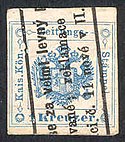Cancellation (philately)
The cancellation of a postage stamp means the identification of a used postage stamp with a postmark or another type of cancellation in order to prevent the postage from being used again.
Forms of cancellation
Today postage stamps are almost exclusively canceled by black postmarks . These stamps usually have a circular shape and indicate the place and date of the cancellation. A special form of the postmark is special .
However, there are numerous other forms of cancellation that can be found especially at the beginning of the postage stamp issues in the 19th century . The most important are:
Advance cancellation
Advance cancellations (also called VEs) have been used by numerous countries for mass deliveries. The valid at that time postal stamps were special letterpress - devalued or hand stamp in advance and so in all the sheets delivered to the Großauslieferer. This made the individual stamping of the items sent later unnecessary and the postal service was simplified.
However, due to this simplification of the postal service, it is no longer possible to tell whether a stamp has already been used or not. For this reason, advance cancellations were only allowed to be used by special major customers who were registered with the Post . Private individuals were not allowed to frank letters with pre-canceled stamps.
In France and the USA, advance cancellations by letterpress printing are still used today.
The sender stamp machines are another form of advance cancellation. The sender uses a special machine to stamp the stamps on the item and then delivers them to the post office. To do this, he also needs authorization from the post office. These VEs occur today in Germany, Switzerland and Liechtenstein.
A special form of advance cancellation is cancellation by newspaper printing . These are found in Austrian and French newspaper stamps (for a fiscal charge), which were glued before the printing of the newspapers in this and canceled by the newsprint. Since the cancellation took place at the same time as the printing, this is basically not a “real” advance cancellation, but merely a newspaper printing cancellation.
Post-cancellation
The subsequent cancellation of postage stamps is a form of cancellation that is still common today. Postage stamps that have inadvertently not been canceled will be canceled afterwards.
Post-cancellation can be done, for example, by the postman who discovers the unstamped postage stamp on the mail item when it is delivered. In such cases, he often crosses them out with a ballpoint pen or something similar.
If the unvalidated stamp is discovered at the arrival post office, it will be canceled with its own postmark. On them you can find the note "subsequently canceled".
Spring balancer devaluation
Smaller post offices in particular, which did not have their own postmarks in the early years of the postage stamp, simply crossed them out ("feather cross devaluation") or handwritten the place names and the date on them. Occasionally, the pen-type cancellation was also required, and the postmark was knocked off next to the franking.
Handwritten canceled postage stamps from this "classical" period are often very popular with philatelists , especially on letters.
Hole devaluation
In some countries postage stamps were canceled by punching them. This can be found, for example, with the first postage stamps in Spain . However, loose pieces cannot be differentiated from subsequently punched (counterfeit) pieces.
Scissor or knife cut devaluation
Another special form of cancellation for postage stamps is scissor or knife cut cancellation. The stamp to be canceled is cut with a pair of scissors or a knife . This happened, for example, in the Ottoman Empire , where the stamps were also postmarked at the same time.
Such cancellations are in most cases less popular with philatelists than a simple cancellation by the postmark.
Cancellation by fiscal stamp
In addition to postal cancellations, there are sometimes also fiscal stamps. This form of cancellation can have various reasons and is explained in more detail in the stamp catalogs for the issues concerned .
Philatelic meaning of cancellations

In the past, perforations or scissor cuts were used in addition to pen and colored pencils.
Philatelists only consider canceled postage stamps worthy of collection if the date and place of the stamp are clearly legible and ideally placed centrally. In most cases, fragmentary stamps render stamps virtually worthless. Exceptions are extremely rare stamps, especially from the early days of philately.
Postal companies also offer postmarks that are primarily used for philatelic purposes (such as the special postmarks used on special occasions ). This also includes the postage stamps with the stamps that are sent by the shipping points. In the past, courtesy stamps were considered to be wanted, today stamps from real postal traffic are usually preferred.
Fakes
Since many older postage stamps are often much rarer than post- fresh ones , it is not uncommon for forgeries of the postmarks ( false postmarks ). Another option is to backdate real stamps. These are known as fake stamps .
There are also numerous forgeries of other forms of cancellation to the detriment of collectors. Handwritten cancellations are often forged as this is particularly easy.
See also
Web links
- http://www.fiskalphilatelie.de/ - Arbeitsgemeinschaft Fiskalphilatelie eV;
- Newspaper fee stamps as cancellation stamps for fiscal stamps. Arbeitsgemeinschaft Fiskalphilatelie eV, accessed on January 12, 2015 .
- Collection of postmarks and postmarks
- Observer : Can I reuse unused stamps?


